
A strong go-to-market strategy is key to successful product launches and prudent resource allocation. As the bridge between innovation and market reality, a GTM strategy navigates the critical path from concept to customer, determining your product or service’s viability and potential success.
Launching a product without a well-defined path to connect with the right customers generally leads to expensive errors.
Whether you push your software to an inappropriate audience, launch it prematurely or tardily in a certain area, or contend with intense competition from similar solutions, you risk investing time and resources into a plan that yields no returns.
At Textmagic, we recognize the significance of a finely-tuned product launch. That is why we’re excited to share a glimpse into our GTM strategy.
What is a go-to-market strategy for SaaS?
Let’s begin by exploring the theory we’ve used to shape our GTM strategy.
A go-to-market strategy for a SaaS company refers to a strategic plan outlining how it will introduce, promote, and deliver its product to the target market. This strategy focuses on:
- Sales approach
- Market analysis
- Marketing tactics
- Customer support
- Distribution channels
- Pricing
- Customer segmentation
Every go-to-market strategy should have these three launch phases.
1. Pre-launch and awareness phase
In the pre-launch phase of a product launch using a GTM strategy, the focus is on market analysis and customer segmentation. This phase involves setting pricing strategies and identifying distribution channels.
Teaser campaigns and targeted marketing tactics generate anticipation and build awareness for the upcoming product.
2. Launch phase
The launch phase shifts the GTM strategy towards detailed messaging and direct sales approaches. Marketing efforts intensify, leveraging various channels such as content marketing, online advertising, and events.
Customer support ensures a positive user experience, while the sales team communicates the product’s value proposition.
3. Growth and maturity phase
After a successful launch, the strategy transitions to sustaining growth. Marketing efforts continue to attract new customers while upselling and cross-selling strategies enhance revenue.
Customer support remains crucial, and adaptation to changing trends and customer feedback drives ongoing product improvements for market longevity.
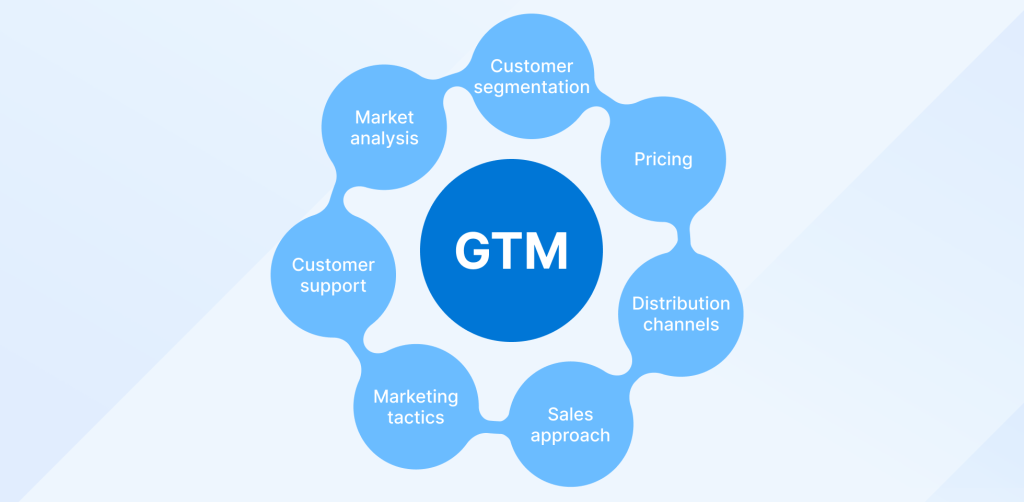
Why you need a strong go-to-market strategy
The primary goals of a SaaS GTM strategy are to position the product successfully in the market, attract the right customers, drive adoption, and achieve sustainable growth.
Let’s explore the reasons why a well-crafted GTM plan is indispensable for your SaaS.
- Enhanced customer experience: With a digital offering, the emphasis of a GTM approach lies in providing both top-notch software and service.
- Engaging business-to-business dynamic: Sales teams need to delve into the specifics of the prospects’ nature, size, and industry to pinpoint decision-makers.
- Versatility in marketing approaches: SaaS companies can effectively communicate how their solutions solve real user problems through personalized messaging.
Go-to-market strategy growth engines
Think of a go-to-market strategy as a streamlined version of a business plan, focusing on a more specific scope. While a business plan encompasses aspects like funding, investments, and long-term projections, these elements aren’t central to a go-to-market strategy.
A go-to-market strategy is tailored to your immediate market entry needs.
While there’s no universal formula, a typical SaaS go-to-market plan revolves around one or more of these four growth engines:
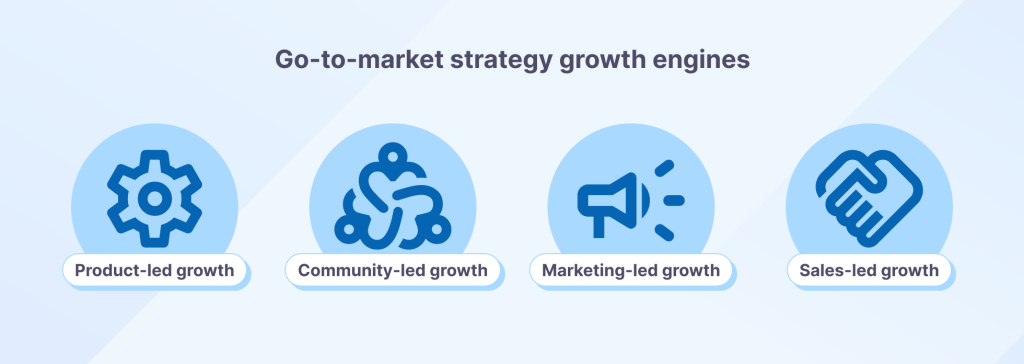
- Product-led growth (PLG): Creating a user-friendly, intuitive product that delivers immediate value to users. With a focus on free trials, freemium models, or self-service sign-ups, PLG allows users to explore and experience the product’s benefits firsthand.
- Community-led growth: Cultivating a dedicated community of users, customers, or enthusiasts who share a common interest in your product or industry.
- Marketing-led growth: Strategic marketing efforts to attract, engage, and convert potential customers. This involves various tactics such as content creation, digital advertising, social media engagement, or email campaigns.
- Sales-led growth: Sales teams engage in direct outreach, product demonstrations, and relationship-building to guide potential customers through buying. This approach is particularly useful for complex or high-ticket SaaS solutions where personalized interactions and tailored solutions are key.
The effectiveness of each strategy depends on the nature of your SaaS product, target audience, market conditions, and overall business goals.
Textmagic’s go-to-market strategy
Launching a new product is a pivotal moment for any SaaS company. At Textmagic, it represents the culmination of years of building communication tools for small and medium-sized businesses, now combined into a complete business communication platform.
We’ve expanded from business texting into a unified solution that includes SMS, WhatsApp, email support, live chat, automation, and task management, all designed to help teams connect with customers faster and more effectively.
Our GTM strategy supports our product-led growth model: we build tools that are simple to start with, easy to scale, and powerful enough that users organically want to keep using them.
But even in a PLG framework, a thoughtful strategy is essential, and ours is built to match the strengths of the Textmagic platform and our customer base alike.
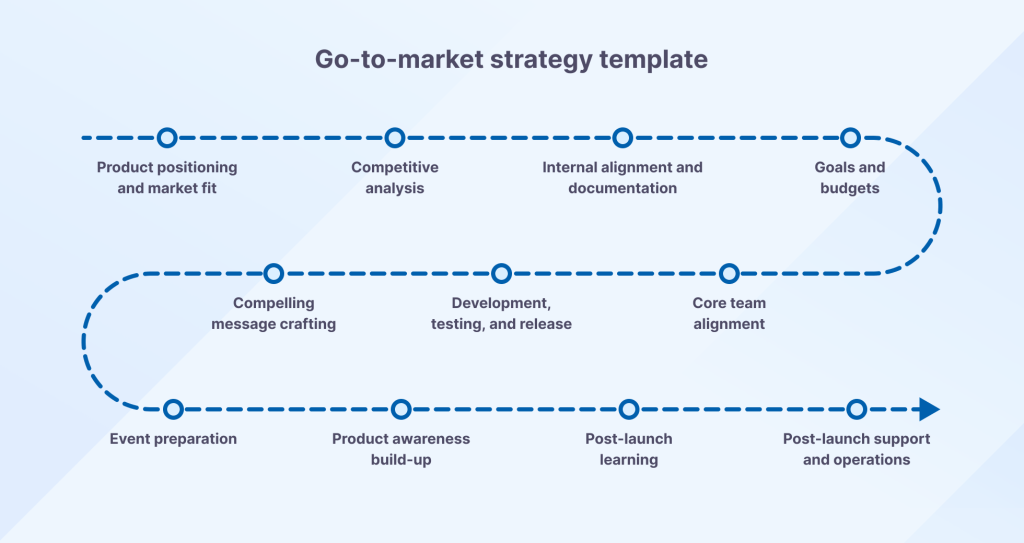
1. Product positioning and market fit
Before developing our expanded platform, we conducted extensive customer research to understand the needs of SMBs who rely on texting, email, and chat to manage their operations.
We discovered that many businesses are forced to combine multiple disconnected tools: one for SMS, one for email campaigns, another for live chat, and another for task tracking. These tools often come with high monthly fees and steep learning curves.
Textmagic solves this by offering a centralized platform that combines:
- Two-way SMS chat
- Mass texting
- WhatsApp, Facebook, and Instagram integration
- Omnichannel chat widget
- Email helpdesk
- Task management
- Customizable automations
- Contact management
- Point AI
- API and Zapier integrations
All of this is delivered with transparent pay-as-you-go pricing or volume-based monthly plans, allowing businesses to scale as needed.
We validated this approach through direct interviews and feedback loops with our users, ensuring the new platform reflects real-world workflows.
2. Competitive analysis
To define our market position, we analyzed platforms that offer partial or overlapping functionality with Textmagic, including:
- SimpleTexting and EZ Texting (SMS and MMS)
- Brevo and Mailchimp (email marketing)
- ClickUp and Trello (task management)
Most of these tools focus on a single channel, often requiring SMBs to manage multiple logins, integrations, and billing cycles. Textmagic’s edge lies in providing multichannel communication and internal coordination under one roof without added complexity or lock-in.
3. Internal alignment and documentation
A robust GTM strategy starts with internal cohesion and clarity. That’s why we started our GTM approach by defining a centralized documentation hub that includes:
- Product scope and feature breakdowns
- Product roadmap and priorities
- Target audience personas
- Ideal use cases and verticals
- Messaging principles and positioning
This ensures cross-functional teams, from engineering and product to marketing and support, are aligned on what we’re building and why.
4. Goals and budgets
Each stage of the launch has defined goals and KPIs:
- Awareness phase: Website traffic, impressions, and organic visibility.
- Early adoption phase: New trial signups and feature adoption rates.
- Post-launch phase: Conversion, retention, and monthly recurring revenue.
We’ve structured budgets accordingly, prioritizing content marketing, outreach campaigns, launch-focused ads, and support resources that align with these phases.
5. Core team alignment
We assembled a launch team to guarantee smooth project coordination. The launch team is cross-functional, spanning Marketing, Product, Support, Finance, and PR departments.
Roles were clearly defined from the outset, with a launch owner, functional leads, shared documentation, and regular standups to maintain alignment and momentum.
6. Development, testing, and release
Creating a robust SaaS product requires rigorous software development and testing phases. Here are a few key aspects related to our approach to developing and testing Textmagic.
6.1. Agile approach to development
Our approach to development is rooted in agile methodologies. We prioritize developing our products in small sprints, ensuring that our focus is on those features and activities that deliver the most value to our customers.
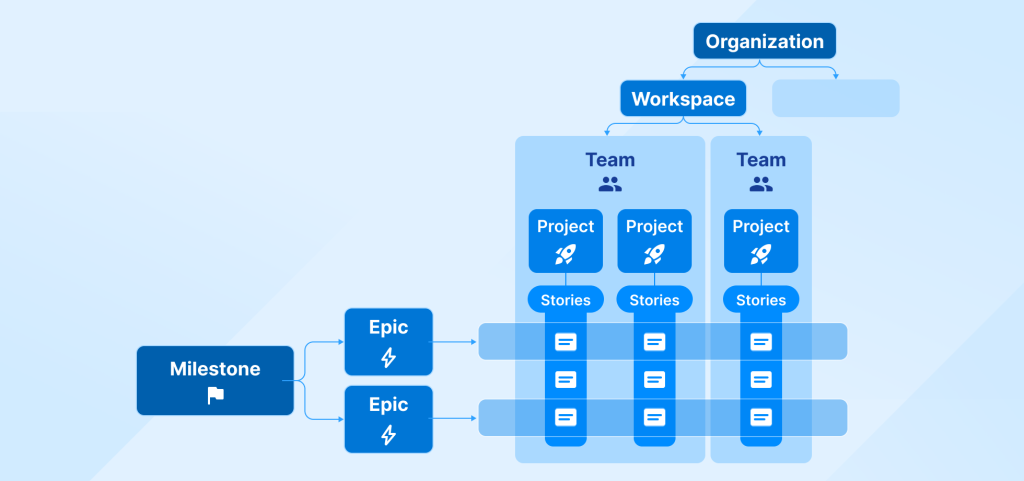
Despite our agile approach to development planning and execution, we cannot make the product available to customers until the basic functionality is fully operational. However, we do pilot-specific components (e.g., live chat support) one at a time.
6.2. Cross-functional sub-teams
To enhance our efficiency and address various facets of product development, we’ve instituted cross-functional sub-teams. Each sub-team is defined by its unique objectives and focus areas, ensuring that every aspect of development aligns with the broader vision of the GTM strategy.
We also scaled our software development team from 5 to 50+ while ensuring that the front-end, back-end, and QA teams remained cross-functional.
6.3. Testing to ensure the quality of the product
Testing is an integral part of our product development journey in our quest to deliver excellence. Before any new feature or change is rolled out to the end-users, it undergoes rigorous testing. This ensures that our product remains reliable and secure and meets all stipulated requirements.
💡 Automated and manual testing methodologies ensure that product functionality and the user experience are top-notch. The testing includes functional testing, performance testing, usability testing, and security testing.
6.4. Launching and mitigating risks
The product launch is planned in stages, and each stage has clear objectives and a target audience. Initially, we plan to pilot the product internally within our company and then move to the beta phase, where we will initially make the product available to selected pilot customers. The public launch is the last stage.
This step-by-step approach helps us mitigate risks and deliver a high-quality product.
Moreover, by having regular check-ins and syncs with the marketing team we ensure that they have visibility into these phases. This allows them to plan, execute, and deliver promotional initiatives at the right time.
7. Compelling message crafting
Developing impactful messaging is essential for a successful market entry. In preparation for Textmagic feature launches, we created a primary messaging and positioning document.
This involved careful consideration of our product, our target audience, our competitive landscape, and our unique value proposition, plus a lot of research.
We developed clear and concise messages that resonate with the target audience and highlight our main differentiators: Textmagic’s messaging highlights the platform’s user-friendliness, AI capabilities, and pay-per-use pricing model.
We used Wynter to test the website page copy and ensure that our audience understood and resonated with our messaging.
The document is used internally by marketing teams as a main “source of truth” for all other communication materials. It touches upon areas like the company’s mission and vision, the ideal customer profile, buyer personas, and industry verticals.
8. Product awareness build-up
Effective marketing amplifies product awareness, especially in the case of a PLG model. We are all about providing high-value content to our target audience even before the product is launched.
- Website: Refreshing the website content and design to create a cohesive user experience and reflect the current offering.
- Blog: Publishing blog articles that address target audience pain points and improve SEO.
- Resources: Crafting gated content (ebooks, whitepapers) to resolve these pain points.
- Social: Publishing social media posts to establish thought leadership.
- Video: Creating videos to showcase the platform’s capabilities.
- Paid media: Performing targeted marketing campaigns to expand the platform’s reach.
- SaaS listings: Increasing visibility on review platforms like Capterra, Saasworthy, SaasHub, and Trustpilot.
9. Post-launch learning
We regularly schedule a detailed retrospective to evaluate:
- Which channels drove the most qualified leads
- Where users got stuck in onboarding
- How messaging resonated across different segments
- Which features were most (and least) used in the first 30 days
These insights guide future rollouts, including upcoming enhancements to templates, workflows, and reporting tools.
10. Post-launch support and operations
Launching Textmagic is merely the beginning of our journey. After a new feature is launched, we maintain our focus on support and operations with:
- An updated knowledge base with walkthroughs, use cases, and how-tos
- New support training sessions for our customer service team
- Internal materials for onboarding and troubleshooting
- Feedback loops with early adopters to guide the roadmap
Of course, adjusting product positioning, messaging, pricing, and customer target segments according to customer preferences, market dynamics, and competitive trends is also something we’re taking into consideration when and if the situation arises.
In the SaaS business, launching a new product or feature is a test of dedication and innovation. Our go-to-market strategy demonstrates our commitment to excellence, so we extend an invitation to join us on our product journey.
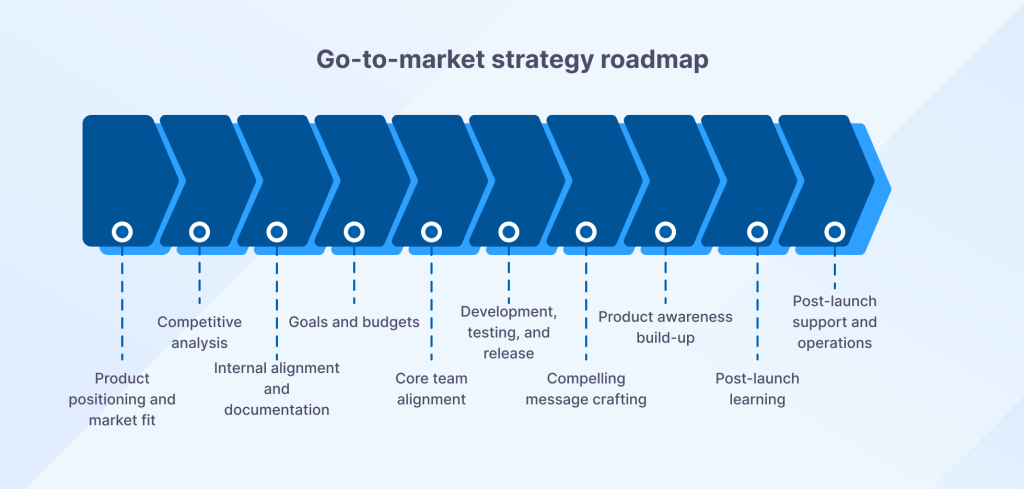
Four go-to-market strategy mistakes to avoid
Ok, now that we’ve gone through everything we’ve done (hopefully right), here are some lessons we learned the hard way. Hopefully you avoid these go-to-market mistakes:
- Overloading customers with too many marketing messages. Instead of spreading your efforts across numerous marketing channels, focus on a core GTM communication strategy. If you need to establish a social media presence, focus your efforts on that one channel. Spreading yourself too thin, or on platforms that do not support your GTM motion, usually leads in weak results.
- Targeting multiple markets simultaneously. SaaS companies often stumble when attempting to target too many geographical regions as part of their GTM strategy. Concentrate on a specific region, like the US or Western Europe. Niche down, to scale up.
- Prematurely pursuing enterprise markets. While enterprise deals may seem appealing, they often lead to challenges for early-stage SaaS companies. Enterprises involve longer sales cycles, more decision-makers, and a preference for established solutions.
- Underestimating outbound strategies. Despite the popularity of inbound marketing, overlooking outbound methods can be a mistake. Tailor your outbound efforts by crafting personalized messages and implementing a multi-touch strategy that combines various channels such as cold emails or cold calls.
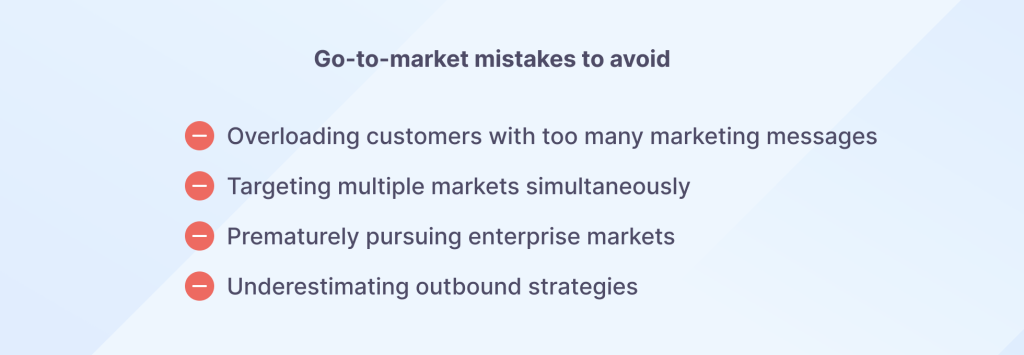
Brilliant SaaS go-to-market strategy examples
We’ll explore two examples of SaaS companies that have achieved remarkable success through their well-executed GTM strategies. These companies leveraged tailored approaches to stand out and engage with their customers.
Zoom: Redefining video conferencing norms for remote work
Long before Zoom became an indispensable part of work-from-home routines, it achieved significant success in its go-to-market journey. They allowed calls of up to 40 minutes without needing credit card details.
This showcased their confidence in their product and provided a taste of the convenience Zoom could offer. The result? A staggering market valuation exceeded $17 billion, even before the COVID-19 pandemic.
As the world shifted towards remote work, Zoom’s groundwork laid the foundation for its widespread adoption and success.
Zoom’s journey exemplifies the power of understanding customer needs, crafting a compelling user experience, and adopting innovative pricing models to capture the market’s attention.
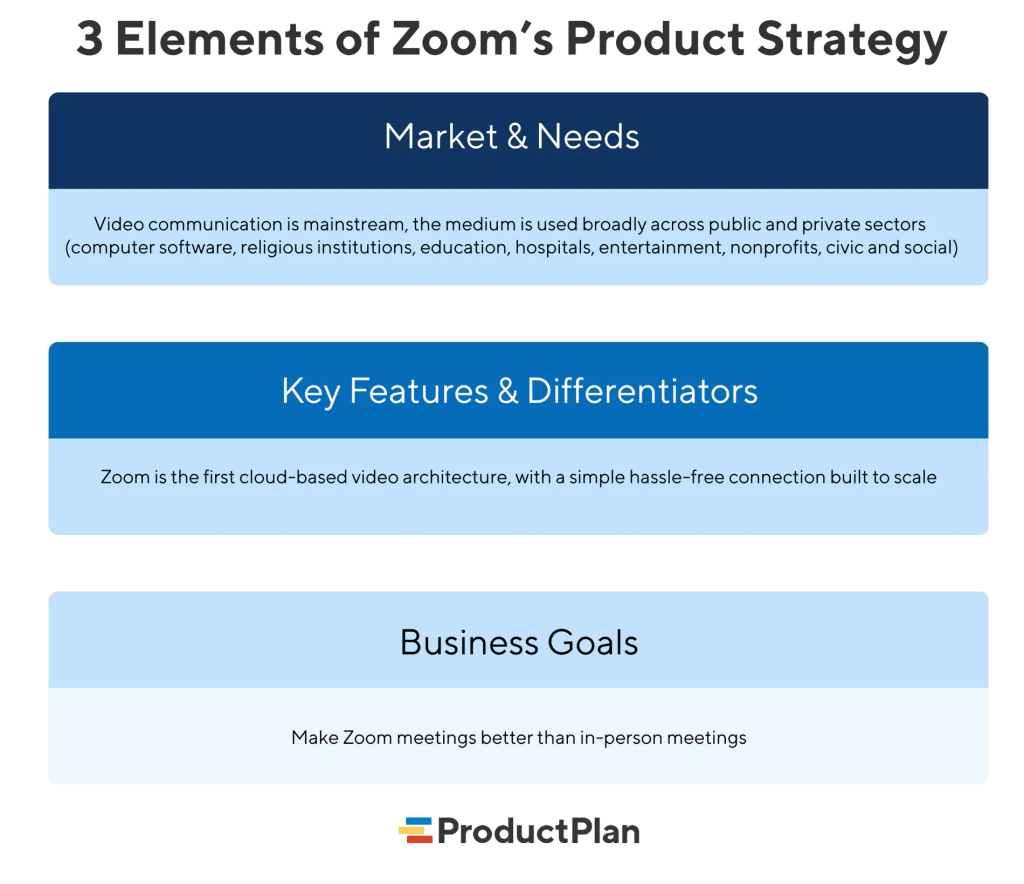
Image source: productplan.com
Slack: Leveraging communication evolution to stand out
Stewart Butterfield, the CEO and co-founder of Slack, and his team, stumbled upon an innovative concept: building a robust platform for internal communication. Their central challenge was persuading brands entrenched in email-based communication to recognize the value of Slack.
Acknowledging that email was the predominant tool for internal team communications, Slack used a GTM approach to strategically position itself as the premier solution for streamlined team interactions.
They showcased its user-friendly attributes: voice and video calls for meetings, text messaging, and shared channels across workspaces. Everything was designed to eliminate the chaos of lengthy email threads.
Despite the growing landscape of internal team communication platforms, Slack has consistently rolled out customized features to address the challenges of its target audience. As of 2023, Slack had over 20 million active users, with projections anticipating 47.2 million daily active users and 79 million monthly active users by 2025.
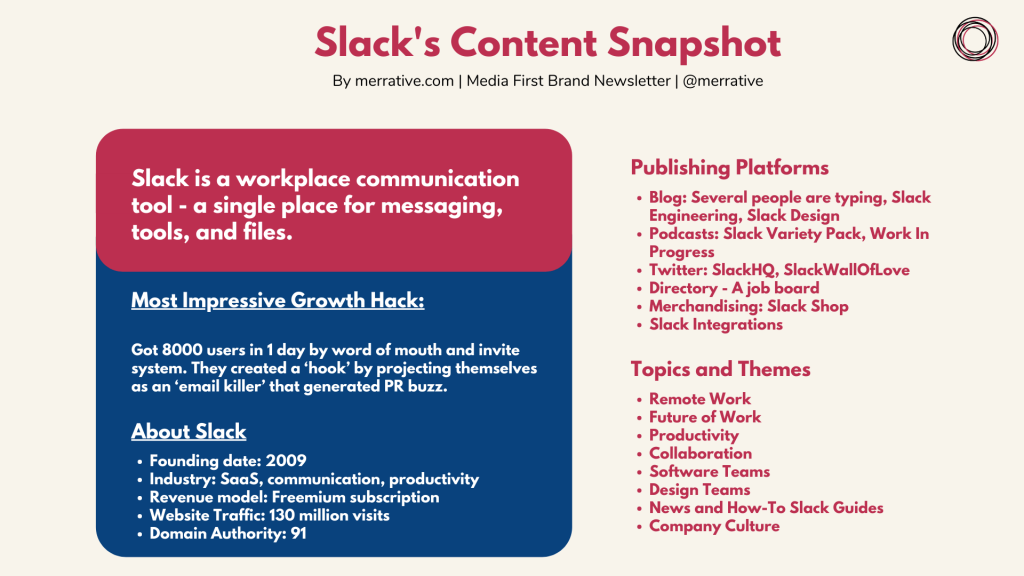
Image source: mediafirstbrand.substack.com
What is your go-to-market strategy?
There isn’t a magical formula for a guaranteed successful go-to-market strategy. It really comes down to understanding your specific business needs and customizing your approach accordingly. It’s also about a bit of luck and timing. The steps we used in our GTM strategy for Textmagic should give you a solid foundation to set yourself on the right track.
You can also use Textmagic to handle the customer support component of your GTM strategy. Here is how it streamlines support in the different phases of the product launch.
- In the pre-launch and awareness phase, Textmagic helps support teams send automated surveys via SMS, email, or WhatsApp to gather insights, uncover customer pain points, and validate demand.
- In the product launch phase, Textmagic helps companies respond quickly to early questions or issues using Textmagic’s intuitive interface, automated replies, and real-time chat.
- In the growth and maturity phase, Textmagic allows businesses to grow with omnichannel messaging and built-in analytics, enabling seamless support across SMS, email, WhatsApp, and chat while capturing valuable data to identify trends and improve service.
When integrating Textmagic into your GTM strategy, you’re not just deploying a business communication platform; you’re setting the stage for exceptional customer experiences.
Frequently Asked Questions (FAQs)
A SaaS GTM strategy is your roadmap for bringing a software product to market. It defines how you’ll acquire customers, position your solution, set pricing, select channels, and support users. It also bridges the gap between product development and real-world adoption.
- Pre‑launch & awareness: focus on market analysis, customer segmentation, pricing, and building anticipation with teaser campaigns.
- Launch: amplify messaging across channels like content marketing, ads, and events, while ensuring strong sales and customer support.
- Growth & maturity: sustain momentum through upselling, cross‑selling, iterative product improvements, and evolving marketing efforts.
SaaS companies commonly adopt one or more growth engines:
- Product-led growth (PLG): freemium or trial users drive adoption through product experience.
- Community-led: growth fueled by user communities and referrals.
- Marketing-led: content, digital ads, and email campaigns boost visibility.
- Sales-led: direct outreach and demos for complex or high-value solutions.
Start with deep customer research to understand SMB pain points, like juggling multiple tools. Then craft messaging around your solution’s unique value (e.g., omnichannel platform replacement). Ground your decisions in user reality by validating assumptions through interviews and real-world input.
Detailed competitor benchmarking (against tools like SimpleTexting, Mailchimp, or ClickUp) helps you identify market gaps. A key differentiator would be offering an all-in-one solution with the flexibility to switch, setting it apart from restrictive, single-channel tools.
Set up a centralized documentation hub covering product scope, ICPs, messaging principles, and feature roadmap. Establish a cross-functional team with clearly scoped responsibilities, shared KPIs, and built-in feedback loops to stay aligned throughout the launch.
Related articles
What is vishing? Unmasking voice phishing scams and techniques
Vishing, an insidious blend of voice communication a...
20+ Marketing growth hacks to accelerate your business in 2025
When aiming to grow your business, it's essential to...
5 Effective strategies to improve SLA response times
The SLA response time metric in service level agreem...
Building customer loyalty: Strategies to retain customers
In today’s highly competitive business environment, ...
10 Good review examples and how we encourage clients to leave feedback
Reviews play a pivotal role in shaping consumer perc...




